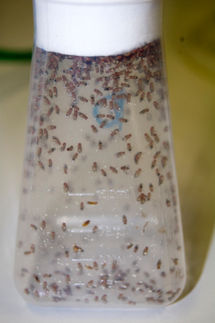Dangerous bacterium hosts genetic remnant of life's distant past
Within a dangerous stomach bacterium, Yale University researchers have discovered an ancient but functioning genetic remnant from a time before DNA existed, they report in Science. To the surprise of researchers, this RNA complex seems to play a critical role in the ability of the organism to infect human cells, a job carried out almost exclusively by proteins produced from DNA's instruction manual. "What these cells are doing is using ancient RNA technology to control modern gene expression," said Ron Breaker, the Henry Ford II Professor of Molecular, Cellular and Developmental biology at Yale, investigator for the Howard Hughes Medical Institute and senior author of the study.
In old textbooks, RNA was viewed simply as the chemical intermediary between DNA's instruction manual and the creation of proteins. However, Breaker's lab has identified the existence and function of riboswitches, or RNA structures that have the ability to detect molecules and control gene expression – an ability once believed to be possessed solely by proteins. Breaker and many other scientists now believe the first forms of life depended upon such RNA machines, which would have had to find ways to interact and carry out many of the functions proteins do today.
The new paper describes the complex interactions of two small RNA molecules and two larger RNA molecules that together influence the function of a self-splicing ribozyme, a structure many biologists had believed had no role other than to reproduce itself. The new study, however, suggests that in the pathogenic stomach bacterium Clostridium difficile , this RNA structure acts as a sort of sensor to help regulate the expression of genes, probably to help the bacterium manipulate human cells.
"They were though to be molecular parasites, but it is clear they are being harnessed by cells to do some good for the organism," Breaker said. This is the sort of RNA structure would have been needed for life exist before the evolution of double-stranded DNA, with its instruction book for proteins that carry out almost all of life's functions today. If proteins are necessary to carry out life's functions, scientists need to explain how life arise without DNA's recipe. The answer to the chicken or egg question is RNA machines such as the one identified in the new study, Breaker said. "A lot of sophisticated RNA gadgetry has gone extinct but this study shows that RNA has more of the power needed to carry out complex biochemistry," Breaker said. "It makes the spontaneous emergence of life on earth much more palatable."
Topics
Organizations
Other news from the department science

Get the life science industry in your inbox
By submitting this form you agree that LUMITOS AG will send you the newsletter(s) selected above by email. Your data will not be passed on to third parties. Your data will be stored and processed in accordance with our data protection regulations. LUMITOS may contact you by email for the purpose of advertising or market and opinion surveys. You can revoke your consent at any time without giving reasons to LUMITOS AG, Ernst-Augustin-Str. 2, 12489 Berlin, Germany or by e-mail at revoke@lumitos.com with effect for the future. In addition, each email contains a link to unsubscribe from the corresponding newsletter.
Most read news
More news from our other portals
Last viewed contents
MediGene: Dose-Finding Trial of Oncolytic Virus NV1020 for the Treatment of Liver Metastases Shows Efficacy Trends
A Clamp for Emerging Flu Viruses - Researchers in Freiburg and Berlin Unravel Secret of Innate Immune Response
Nuevolution Announces Collaboration in Drug Discovery with Boehringer Ingelheim
Bone degradation process within metastatic breast cancer identified
FDA Grants Orphan Status for ATX-F8-117 for the treatment of Haemophilia A patients in the US
Novel Stem Cell Therapy From Cellonis Biotechnologies Can Help Children With Diabetes Get Back Their Normal Lives




















































